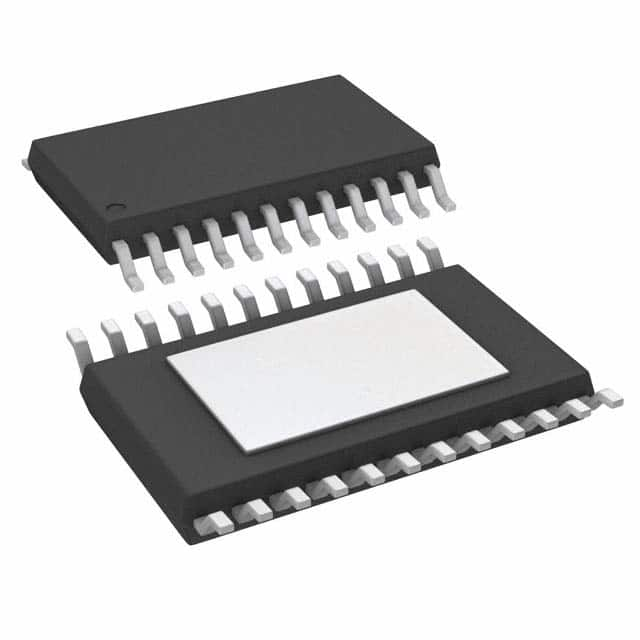TLC5948APWP
Product Overview
Category
The TLC5948APWP belongs to the category of integrated circuits (ICs).
Use
This IC is commonly used for controlling LED displays and lighting systems.
Characteristics
- High grayscale resolution
- Multiplexing capability
- Daisy-chainable
- PWM (Pulse Width Modulation) control
- Constant current output
Package
The TLC5948APWP comes in a TSSOP (Thin Shrink Small Outline Package) package.
Essence
The essence of the TLC5948APWP lies in its ability to provide precise control over LED brightness levels, making it ideal for applications requiring high-quality LED displays or lighting systems.
Packaging/Quantity
The TLC5948APWP is typically packaged in reels, with each reel containing 2,500 units.
Specifications
- Supply Voltage: 3.3V - 5V
- Number of Channels: 16
- Maximum Output Current per Channel: 120 mA
- Grayscale Resolution: 12 bits
- Communication Interface: Serial (SPI)
- Operating Temperature Range: -40°C to +85°C
Detailed Pin Configuration
The TLC5948APWP has a total of 32 pins, which are assigned as follows:
- VCC
- GND
- SIN
- SCLK
- XLAT
- BLANK
- DCPRG
- VPRG
- IREF
- OUT0
- OUT1
- OUT2
- OUT3
- OUT4
- OUT5
- OUT6
- OUT7
- OUT8
- OUT9
- OUT10
- OUT11
- OUT12
- OUT13
- OUT14
- OUT15
- SOUT
- XERR
- VLED
- GND
- GND
- GND
- VCC
Functional Features
- High Grayscale Resolution: The TLC5948APWP supports 12-bit grayscale resolution, allowing for smooth and precise control of LED brightness levels.
- Multiplexing Capability: With its multiplexing capability, this IC can control multiple LEDs using a limited number of pins.
- Daisy-Chainable: Multiple TLC5948APWP ICs can be daisy-chained together to control a larger number of LEDs without requiring additional microcontroller pins.
- PWM Control: The Pulse Width Modulation (PWM) control feature enables accurate dimming of LEDs by adjusting the duty cycle of the PWM signal.
- Constant Current Output: The TLC5948APWP ensures a constant current output for each LED, resulting in consistent brightness levels.
Advantages and Disadvantages
Advantages
- High grayscale resolution allows for smooth LED dimming.
- Multiplexing capability reduces the number of required pins.
- Daisy-chainability simplifies the control of large LED arrays.
- Constant current output ensures consistent brightness levels.
Disadvantages
- Limited to controlling LEDs and not suitable for other types of devices.
- Requires an external microcontroller for communication and control.
Working Principles
The TLC5948APWP operates by receiving control signals from an external microcontroller through the SPI interface. It uses these signals to adjust the PWM duty cycle for each LED channel, thereby controlling the brightness levels. The IC also incorporates a constant current source for each channel to ensure consistent LED brightness.
Detailed Application Field Plans
The TLC5948APWP finds applications in various fields, including: - LED displays for advertising boards - Architectural lighting systems - Automotive lighting - Stage lighting - Decorative lighting
Detailed and Complete Alternative Models
- TLC5947APWP: Similar to the TLC5948APWP, but with 24 channels instead of 16.
- MAX7219CNG: A different IC suitable for controlling LED matrices.
- WS2812B: An addressable RGB LED controller with built-in PWM control.
These alternative models offer similar functionalities and can be considered based on specific project requirements.
Word count: 536 words
Senaraikan 10 soalan dan jawapan biasa yang berkaitan dengan aplikasi TLC5948APWP dalam penyelesaian teknikal
Sure! Here are 10 common questions and answers related to the application of TLC5948APWP in technical solutions:
Q: What is the TLC5948APWP? A: The TLC5948APWP is a 16-channel, constant-current sink LED driver that can be used to control LEDs in various applications.
Q: What is the maximum current per channel that the TLC5948APWP can handle? A: The TLC5948APWP can handle a maximum current of 120 mA per channel.
Q: Can the TLC5948APWP be used to drive RGB LEDs? A: Yes, the TLC5948APWP can be used to drive RGB LEDs by using multiple channels to control each color component.
Q: How many TLC5948APWP devices can be daisy-chained together? A: Multiple TLC5948APWP devices can be daisy-chained together to control a larger number of LEDs. The exact number depends on the specific application and system requirements.
Q: What is the communication interface used to control the TLC5948APWP? A: The TLC5948APWP uses a serial interface (SPI) for communication with a microcontroller or other control device.
Q: Can the TLC5948APWP be used in high-power LED applications? A: No, the TLC5948APWP is designed for low to medium power LED applications. For high-power LED applications, a different LED driver with higher current handling capabilities should be used.
Q: Does the TLC5948APWP require external components for operation? A: Yes, the TLC5948APWP requires external resistors for setting the LED current and capacitors for decoupling and stability purposes.
Q: Can the TLC5948APWP be used in automotive applications? A: Yes, the TLC5948APWP is suitable for automotive applications as it can operate within the required temperature range and has built-in protection features.
Q: What is the maximum clock frequency supported by the TLC5948APWP? A: The TLC5948APWP supports a maximum clock frequency of 30 MHz.
Q: Are there any evaluation boards or development kits available for the TLC5948APWP? A: Yes, Texas Instruments provides evaluation boards and development kits that can be used to prototype and test applications using the TLC5948APWP.


